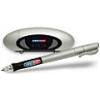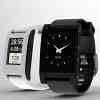New Technology Gadgets

New technology gadgets provide consumers with functionality and convenience. Our smart phones are a perfect example.
They allow us to access the web, email, text, chat, take pictures, organize information and control other devices.
So in a world of rapidly advancing technology, why do we still use plastic credit cards. Seems archaic. Well, things are about to change.
Plastic cards are going to be replaced with future generation smart phones and the process has already started with brands like Google Wallet and Apple iWallet.
How It Works
Your credit card information is embedded in your smart phone instead of on a plastic card.
You point or touch your phone to a point-of-sale device, or another smartphone, which communicates (see: near field communication) purchasing information to your touch screen.
You select which card you want to use and click Ok. A receipt is generated on your screen and the transaction is saved to a secure cloud file.
It's fast, convenient, and digitally organized. No paper receipts to keep. No statements to review. No plastic cards to carry. And it's more secure.
Here's why.
A card can be stolen and so can a smart phone. But here is the difference. No one can access your smart phone because it has biometric encryption. The phone won't function without your fingerprint, voice, or retina identification.
Your credit won't function unless you can be identified by your phone. Tampering deletes encrypted files. Financial information is stored on a bank cloud, not on your phone.
So what does all this mean?
 You will use your smart phone to purchase goods or services online or offline and it will function as a credit and debit card.
You will use your smart phone to purchase goods or services online or offline and it will function as a credit and debit card.
In fact, your phone will serve as an authentication device for any transaction including but not limited to memberships, loyalty and gift programs.
It may even replace your drivers license and passport.
Virtual Wallet
Imagine this scenario.
A student uses his smart phone to locate and find an Italian restaurant. He searches and finds a coupon he can use. He drives to the restaurant and has his phone search for a parking spot. He finds a spot and parks his car. He uses the phone to complete a parking fee transaction with a meter. The meter transfers a receipt and text messages about an upcoming street festival.
 Inside the restaurant he orders his meal with a beer. The waitress asks for proof of age. The student places his finger on his phone and produces his drivers license on his screen.
Inside the restaurant he orders his meal with a beer. The waitress asks for proof of age. The student places his finger on his phone and produces his drivers license on his screen.
After his meal and beverage, he points his phone to the point-of-purchase station, finds his bill, selects his payment method, includes his coupon, pays, receives his receipt, gets another coupon, plus a discounted movie pass.
He leaves and visits a shoe store down the street. He scans the QR codes and reads about various models of athletic shoes. He does a price comparison search and also looks for coupons. He couldn't find any coupons but he shows the retailer his price comparison information and negotiates for a better price on a pair of shoes.
The retailer agrees to provide a 30% discount if the student joins their loyalty program. The student agrees.
![]() A short form is transferred to the student's phone as well an invoice for the shoes. The student activates his read and voice recognition application and tells the phone to fill out the form and send it back to the retailer.
A short form is transferred to the student's phone as well an invoice for the shoes. The student activates his read and voice recognition application and tells the phone to fill out the form and send it back to the retailer.
He also instructs the phone to pay for the shoes using his debit card. The phone completes these tasks and confirms by voice that the transactions have been completed.
He grabs his shoes and takes a picture of them. He tells his phone to inform a list of his friends about his new shoes, to send a picture, and include the name and location of the store.
This concept of integrating financial transactions with our smart phone applications is referred to as a "money wallet" or "virtual wallet" system, and a lot of competitors are gearing up for a piece of this pie.
Credit Cards
Credit cards were first used in the 1920s, became popular in the 50's, and were essentially controlled by the banking duopoly of Mastercard/Visa starting in the 80's because of their proprietary networks for processing payments between merchants and card issuing banking institutions.
But then the Internet was invented, wireless technologies, mobile networks and smart phones evolved, and suddenly a lot of companies can play the credit card game. So new alliances and partnerships are being formed.
A virtual wallet system consists of - a network infrastructure, software, and a device.
Here is an example of a virtual wallet system currently operating in Kenya. Kenya has a population of approximately 41 million. Thirty-five percent (about 14 million) conduct all their financial transactions through the mobile phone provider Safaricom, which is owned by Vodafone - the world's largest mobile network that also owns 45% of Verison Wireless, the largest mobile phone network in the United States.
Safaricom is allied with Nokia and Song Ericsson and provides the financial transaction software required for their virtual wallet system.
But the duopoly of MasterCard/Visa are making their own alliances with phone makers and mobile networks to create their own virtual wallet systems.
So it remains to be seen how all these virtual wallets are going to function in the market place. Who is going to be suing who and what deals will result.
But one thing is certain - credit cards will be obsolete.
Sources: paywithisis.com; icache.com; paypass.com; www.v.me/; wikipedia.com


|
| New handheld device can identify you by scanning the veins in your hands. |

|
| When you write with this pen, it saves the text to your smart phone. |






